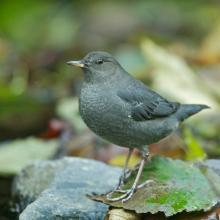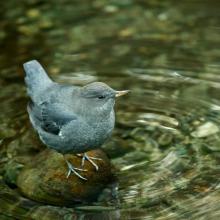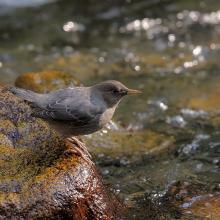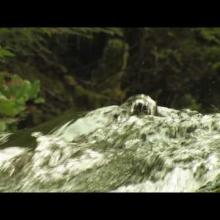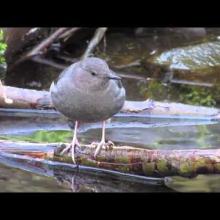

Join BirdNote tomorrow, November 30th!
Illustrator David Sibley and actor H. Jon Benjamin will face off in the bird illustration battle of the century during BirdNote's Year-end Celebration and Auction!
"[H]is music is that of the streams refined and spiritualized. The deep booming notes of the falls are in it, the trills of the rapids, the gurgling of margin eddies, the low whispering of level reaches, and the sweet tinkle of separate drops oozing from the ends of mosses and falling into tranquil ponds." - John Muir The Mountains of California, 1894
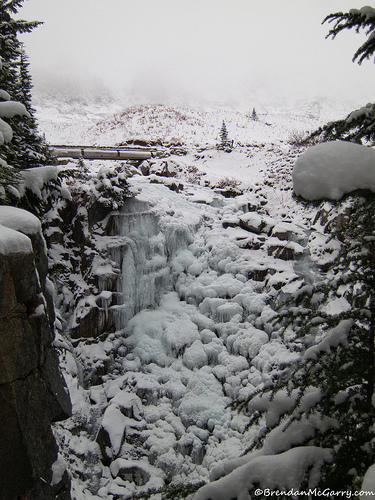
The seasons can change quickly in the high Cascades. One day in early November, a crust of fall hung over Paradise Valley, but a few juncos, Audubon’s Warblers, and Varied Thrushes were still about. At Myrtle Falls, an American Dipper rattled by me, the latest I’ve ever seen one there. Three days later, a foot of snow was on the ground, and Myrtle Falls was all but ice. All the birds were gone, including the dipper, back to lower reaches of the mountain. The dippers gave me pause – did they just fly downstream, or was something else going on?
Considering a constraint that appears rather limiting – that is, being an obligate of relatively clean running water – the American Dipper (Cinclus mexicanus) is an extremely versatile species. They range from Alaska to Panama, in the US and Canada from the Rocky Mountains west. Migrating south, for a plush winter hideout in a tropical creek, isn’t part of the deal either. They are not migratory in a latitudinal sense. Rather they are altitudinal migrants. Still, a pair will often occupy a productive territory throughout the year. So if a territorial pair (and believe me – they are territorial) stays in the same place, and these birds inhabit rivers and streams exclusively, how does their dispersal work? Where do they go when the weather gets bad up in the mountains, assuming there are others downstream? Being territorial, generally solitary birds, it’s not as if they gather in winter flocks.
John Muir would have called dippers “water ouzels.” The name dipper describes not their habit of dipping into water to find food, (for they and their three congeners are the most aquatic passerines in the world), but their movement on land. Anyone who has spent even a few minutes watching a dipper will have seen it alight and bob its body up and down in a weird little jig. An agitated bird will dip even more rapidly. This might be a method of display that doesn’t require the bird to constantly raise its voice above the torrents, although they are fairly adept at that, too. Most times when I see them, I hear them first.
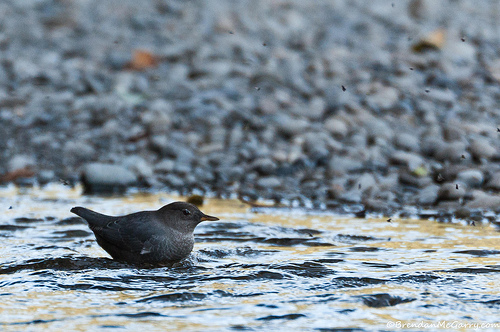
So back to the initial question – when the weather turns bad, where do these resident birds go? Dippers are extremely hardy birds, reportedly enduring -50°C periods in Alaska. And if their stream doesn’t freeze and has food, they may be found year round where they breed, relying on a low metabolism and an extra thick coat of feathers to endure. Multiple pairs of dippers can occupy a single drainage, simply dividing up the waterway in parcels. In cases where a pair higher up the drainage disperses seasonally, it’s surmised they may skip over a pair wintering below them.
These answers are about what I expected, but I always enjoy delving a bit deeper to test my ideas with research that’s been done. I’d never have known that in some places, densities may get quite high in winter, including a finding of 35 birds/km along British Columbia’s Okanagan River. It's strange to think that a bird will fiercely chase away interlopers during the breeding season, and then tolerate such proximity just a few months later.
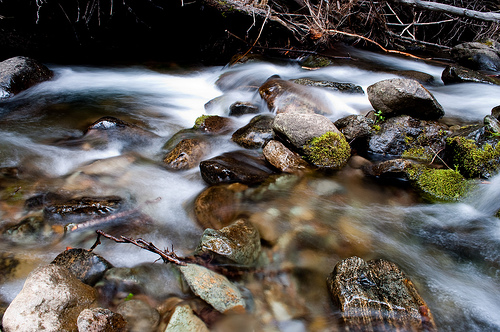
A few years ago, I had the pleasure of spending several afternoons with a family of dippers in the Sierras. Beneath the bridge that crossed a rushing creek to my summer quarters, a pair of dippers had raised their young. I remember one afternoon in particular that I spent watching a youngster being fed. When the parents weren't stuffing food down its gullet, the fledgling sang a mangled dipper slurry. It was so charming I couldn’t help giggling at this bird, which appeared to lack all self-awareness of his butchered song. Had he noticed me, I suspect the reaction would have been that of a teenager caught singing boisterously off key.
After his parents had finished their job of raising him, he eventually dispersed to another drainage somewhere nearby. And when he flew off, his parents did something pretty astonishing. They molted all their flight feathers simultaneously. This means that they could not fly for a short period, relying only on the stream for protection from predators. For a passerine, this is incredibly peculiar.
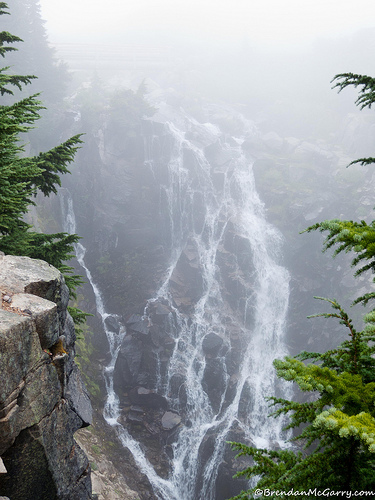
I’ve never seen a dipper anywhere but near running water or the occasional lakeshore or coastline. But these youngsters have to disperse between drainages at some point. This means they might occasionally cross land. Some have surmised this happens at night, since there are no observations of cross-drainage dispersal during the day. This only sort of makes sense to me. On the one hand, moving from their territory at night could be safer. However, you also might think that they’d just go downstream till they found a fork and follow that elsewhere.
If I got to choose, I’d imagine them waiting till the cover of darkness, listening for the moonlit tinkle of running water, as they hurry through the forest or high above on their search. A night exodus in search of the torrent.
###
This blog entry was originally posted on November 26, 2012 at http://wingtrip.org/.
All photos © Brendan McGarry


